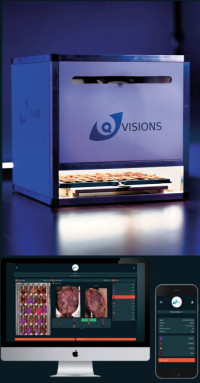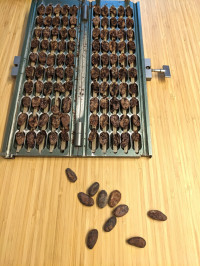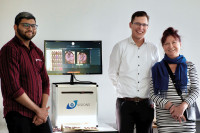The cut test is an integral part of cocoa quality assurance. It is used to quantitatively assess defects and the degree of fermentation in sampled beans, allowing conclusions to be drawn about overall quality and market value. Especially in light of the recent surge in cocoa prices, precise quality determination is essential to implement targeted measures that maintain product quality and the characteristic chocolate flavour.
By Tobias Jeauthe, Computer Vision Specialist
Until now, the inspection has been conducted visually by experienced examiners along the supply chain. Despite attempts to standardise the process, it remains subjective: Even trained experts may evaluate identical patterns differently. Additionally, the method is time consuming, leading to limited sample sizes. The shortage of qualified personnel further restricts the process.
QVisions has developed a deep-learning-based software trained on thousands of images from key cocoa growing regions, enabling the automated classification of cocoa beans.
In collaboration with Rausch GmbH as an official partner and cocoa researcher Dr Christina Rohsius, the solution benefits from extensive scientific expertise. It seamlessly integrates into existing processes: Beans are cut, photographed, and analysed by the software. The result is a digital count of detected defects. If desired, identified defects can be visually highlighted for further review.
During development, it became evident that factors such as insufficient lighting or low image resolution could impair the detection of certain defects, particularly insect infestations. To ensure consistent results, a specialised photo box was developed to provide standardised imaging. The solution remains highly flexible: The software can be used on both mobile devices and desktop PCs, requiring only a connection to the photo box for image capture. This ensures seamless integration into existing workflows.
The system has already been successfully tested with independent quality control experts, processors, warehouse operators, and chocolate manufacturers. Beans from various origins were analysed, and the results of manual cut tests were compared with AI-based analyses. With a defect detection accuracy of over 90%, the automated cut test control proves its feasibility and practical value.
Currently, the focus is on the processing industry. However, QVisions plans to make the technology available directly in cocoa producing countries. Mobile applications could enable farmers to take early action to improve quality contributing to more sustainable supply chains and fairer trade. One thing is certain: The future of cocoa quality assurance is digital, objective, and efficient.




